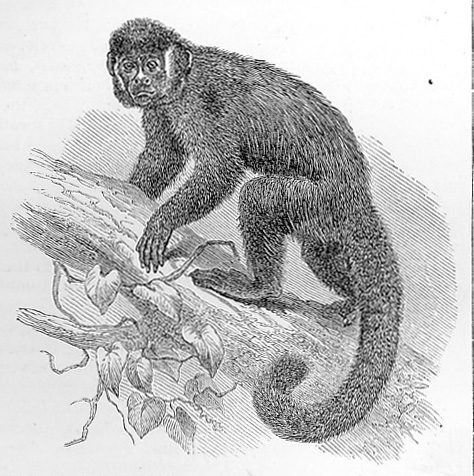1902 Encyclopedia > Ape > Ape: Family II - Cebidae, Sub-Family 1: Cebinae. Spider Monkeys. Woolly Monkeys. Sapajous.
Ape
(Part 9)
<
(B) Apes Classified by Family, Sub-Family and Genera (cont.)
Ape: Family II - Cebidae, Sub-Family 1: Cebinae. Spider Monkeys. Woolly Monkeys. Sapajous.
The first sub-family consists of the four genera, Ateles, Eriodes, Lagothrix, and Cebus.
The genus Ateles is composed of the spider monkeys, which, as their name implies, have long and slender limbs. They have also a very long tail, which is in the highest degree prehensile, being naked beneath towards the tip, for more secure prehension. So powerful is the grasp of this organ that the whole body can be sustained by it alone. It even serves as a fifth hand, as detached objects, otherwise out of reach, can be grasped by it, and brought towards the hand or mouth. Their prehension is in other respects exceptionally defective, as the spider monkeys alone amongst the Cebidae (like the Colobi amongst the Simiadae) have the thumb reduced to a mere tubercle. Their laryngeal sac opens medianly, but from the back part of the trachea, just below the cricoid cartilage.

Fig. 8 -- The Black-handed Spider Monkey (Ateles melanochir). From Pro. Zool. Soc. 1871, pl. 15.
The spider monkeys are very gentle in disposition, and, by this and by their long limbs and special fitness for tree-life, seem to represent in an analogous manner in the New World the gibbons of the Old. Nevertheless, in spite of their admirable adaptation for arboreal life, their comparatively slow progression offers a marked contrast to the vigorous agility of the gibbons. Their hair is long, but not woolly. Species described are -- Ater, Pentadactylus, Paniscus, Marginatus, Belzebuth, Melanochir, Hybridus, Vellerosus, Albifrons, Rufiventris, Variegatus, Griescens, Cucullatus, and Fuscipes.
Three species of ape having much general resemblance to spider monkeys have been erected into the genus Eriodes (E. arachnoids, hemidactylus, and hypoxanthus). These animals, which are from South-Eastern Brazil, have the fur woolly, the thumb more or less rudimentary, the nails very laterally compressed, and the nostrils more approximated than in the other Cebidae.

Fig. 9 -- Humboldt's Lagothrix (Lagothrix Humbodltii). From Pro. Zool. Soc. 1863, pl. 31.
The woolly monkeys, Lagothrix, differ from the two preceding genera in having the thumbs well developed. Their nails are compressed laterally, as in Eriodes, but their nostrils are not approximated. As their name implies, their fur is woolly. Like Eriodes and Ateles, they have the tail strongly prehensile, and naked beneath towards the tip. The species which have been described as distinct are -- Canus, Humboldtii, Castelnaui, Tschudi, and Geoffroyi.

Fig. 10 -- The White-cheeked Sapajou (Cebus leucogenys). From Pro. Zool. Soc. 1875, pl. 45.
The genus Cebus, the typical genus of American apes, is composed of the sapajous, so commonly seen in captivity, and so much used for the exhibition of tricks of various kinds. Smaller in size, they are more robust in form than are the spider monkeys. They have well-developed thumbs, and their tail is curled at the end, but, not being naked beneath, is less strongly prehensile than in the three preceding genera. The sapajous have a pleasing voice, a flute-like whistling tone. The different species are very ill-defined, the individual differences being so numerous and so considerable. The species described are the following:-- Capucinus, Hypoleucus, Elegans, Robustus, Apella, Cirrifer, Flavus, Castaneus, Barbatus, Frontatus, Chrysopus, Variegatus, Versicolor, Leucocephalus, Flavescens, Annellatus, Subcristatus, Capillatus, Fatuellus, and Vellerosus.
Read the rest of this article:
Ape - Table of Contents
|


